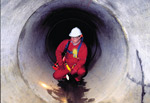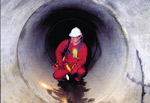
Confined Space Entry Compliance
Given the human costs associated with a confined space accident, buying and using a confined space monitor is one of the best investments for any company.
- By Sarah Ursulan
- Nov 01, 2009
Confined space entry presents a potential hazard in numerous industries. Whether it is an inspection of an aircraft fuel tank, entering the hold of a barge, working in an underground utility vault, or cleaning a wine fermentation tank, education and safety are important when entering confined spaces. Confined space accidents frequently have many common factors, even if they take place under very diff erent circumstances. Unfortunately, many accidents claim multiple victims because, in addition to the initial casualty or casualties, would-be rescuers are also killed or injured.
Establishing and adhering to safe confined space entry procedures is a must. When entering a confined space, workers must be properly trained and equipped, and procedures must be followed.
Recognize the Hazards
In Kentucky, a police officer and two sewer workers were overcome by gas at the bottom of an underground pumping station while attempting to rescue a third worker. All four were pronounced dead at the scene.
At an Oklahoma wastewater treatment plant, one worker died of asphyxiation and another was injured aft er entering a confined space. The company they worked for was cited by the Occupational Safety and Health Administration (OSHA) for not providing appropriate equipment and training.
According to OSHA, a confined space is defined by three factors. The space must be large enough for a worker to enter and cannot be designed for continuous worker occupancy. Third, a confined space has limited openings for entry and exit. Permit-required confined spaces may contain known or potentially hazardous atmospheres. There also may be material with the potential for engulfment, inwardly sloping walls, or dangerously sloping floors. Any other additional serious safety hazards also require a permit before any confined space entry. Employers must clearly identify permit-required confined spaces by posting danger signs.
Confined spaces may contain toxic hazards that can be detected only through testing. Oxygen (O2) deficiency, hydrogen sulfide (H2S), carbon monoxide (CO), and methane (CH4) are common hazards in confined spaces that can be detected with a portable gas monitor. Other gas hazards may be present, depending on the industry. For example, in the beer and winemaking industry, carbon dioxide is a serious hazard because it is produced as a byproduct of fermentation.
An oxygen-deficient atmosphere can be the result of oxygen displacement by a toxic or inert gas. Microbial action, oxidation caused by rusting metal, combustion, and absorption also can create an oxygen- deficient environment. Air is generally considered to be oxygen deficient whenever the concentration is lower than 19.5 percent. Impaired judgment, increased pulse and respiration rate, fatigue, and loss of coordination can occur when oxygen levels fall between 19.5 and 12 percent. Between 6 and 10 percent, nausea, vomiting, and a loss of consciousness leading to death are possible.

Multi-sensor confined space instruments are increasingly compact, rugged, easy to use,and much less expensive than ever before.
The possibility of the presence of H2S gas is another confined space hazard. H2S is produced as a byproduct of microbial activity. At very low concentrations, H2S smells like rotten eggs, however, at slightly higher concentrations, people rapidly lose their sense of smell. Relying on a portable gas detector for H2S readings, and not sense of smell, is the most reliable method of ensuring that workers are notified well before dangerous levels are reached. In the range of 200 to 300 ppm, eye inflammation, respiratory tract irritation, and a loss of consciousness can occur. When lev-els of H2S reach 500 to 700 ppm, death will occur within 30 minutes to an hour.
Because H2S is heavier than air, it can collect in low-lying areas and confined spaces. Knowing the vapor density of gases can be heavier or lighter than air means it is essential to test at various levels in a confined space. Stratified testing prior to entering a confined space will alert workers to potentially dangerous environments. A confined space gas detector kit makes stratified testing easy and generally includes a multi-gas monitor with pump, 10-foot sampling hose for pre-testing (longer lengths are available), spare batteries (rechargeable or alkaline), quad-gas cylinder for bump testing, and calibration with gas regulator, all conveniently contained in a rugged carrying case.
Besides H2S, the decomposition of organic waste materials can produce methane. Leaks in gas pipelines can be another source of methane in confined spaces. Although methane is the most commonly encountered combustible gas hazard, it is important to monitor for additional combustible gases. A combustible sensor that reads in the percent LEL range is excellent for measurement of methane, propane, and other common combustible gases that are not detectable by PID.
Carbon monoxide, which is produced as a byproduct of incomplete combustion, presents another hazard in confined space entry. The internal combustion engine exhaust from vehicles, pumps, and compressors running in the vicinity of a confined space can create a buildup of carbon monoxide. A concentration of only 1,600 ppm can be fatal within hours. Even lower levels of exposure can result in death if there are underlying medical conditions or there are additional factors, such as heat stress.
PPE for Confined Spaces
A portable, multi-gas detector with H2S, CO, O2, and combustible (% LEL) sensors is ideal for most confined space entry applications. A five-gas monitor can provide an extra sensor to protect against other potentially deadly hazards that are specific to a job site or industry. The addition of a non-specific PID sensor creates the capability of detecting a broad range of dangerous volatile organic compounds (VOCs). In some European countries, it is also mandatory to monitor for CO2 in confined spaces. The types of sensors selected should reflect the known and potential atmospheric hazards associated with the environment to be monitored.
Aft er initial testing is complete, testing of the atmosphere within the space must continue to ensure the area remains safe. If a hazardous atmosphere is detected during entry, employees should exit immediately, re-evaluate the space, and take corrective measures.
Do not rely on human senses for detection of potentially harmful gases in confined spaces. Multi-sensor confined space instruments are increasingly compact, rugged, easy to use, and much less expensive than ever before. The use of properly maintained gas detectors must be included in any confined space entry program. Given the human costs associated with a confined space accident, buying and using a confined space monitor is one of the best investments for any company.
Bump Testing and Calibration
Workplace environments can be harsh, and gas detectors are subjected to all kinds of conditions that can aff ect their operation. Instruments can be physically damaged, sensor ports can become obstructed by dirt and oils, sensors can be damaged by exposure to gas concentrations that exceed their detectable limit, and sensors can be exposed to compounds in the atmosphere that can degrade their performance.
The only way to guarantee an instrument will detect gas accurately and reliably is to test it with a known concentration of gas. Exposing the instrument to a known concentration of test gas will show whether the sensors respond accurately and the instrument alarms properly.
There are two methods of verifying instrument accuracy:
1. A functional bump test
2. A full calibration
Each is appropriate under certain conditions. A bump test verifies calibration by exposing the instrument to a known concentration of test gas. The instrument reading is compared to the actual quantity of gas present, as indicated on the cylinder. If the instrument's response is within an acceptable tolerance range of the actual concentration, then its calibration is verified. Users are recommended to check with the gas detection equipment manufacturer for the acceptable tolerance ranges.
Instruments should be "zeroed" before the bump test to give a more accurate picture of the bump test results. Also, the test should be conducted in a clean, fresh-air environment. When performing a bump test, the test gas concentration should be high enough to trigger the instrument alarm. If the instrument fails a bump test, it must be adjusted through a full calibration before it is used.
During a period of initial use of at least 10 days in the intended atmosphere, calibration should be verified daily to ensure nothing is in the atmosphere to poison the sensors. The period of initial use must be of sufficient duration to ensure the sensors are exposed to all conditions that might adversely aff ect the sensors. If the tests demonstrate that no adjustments are necessary, the interval between checks may be lengthened, but it should not exceed 30 days. If the instrument fails a bump test, it must be adjusted through a full calibration before it is used. When calibrating an instrument, always follow the manufacturer's recommended calibration frequency and procedure.
Following Protocol
Picture this: a busy industrial facility, workers with gas detectors, and safety protocol that must be adhered to. How can you tell people are using instruments that are properly maintained? How can you tell people have even turned their instruments on?
Diff erent gas detection manufacturers have a variety of methods to ensure instruments are properly maintained, as well as bump tested and calibrated. If an on-site audit is carried out, most instruments must be physically examined. Portable gas detectors with messages on start-up that verify bump test and calibration status aff ord one method of verifying detector maintenance. Another common way is reviewing datalogs on the detector, computer, or manual logs.
Confidence flashes are an innovative means of signifying proper detector management. Visible from a distance, confi- dence flashes verify normal operation and compliance to both users and supervisors. Eliminating the need to manually check each detector saves time. Workers who do not turn their detectors on become highly visible.
Icons signifying detector maintenance are another visual management technique for portable gas monitors. When icons are easily recognizable, language barriers can be transcended. Icons also can save time during safety audits.
Safety First
Most confined space deaths that result from exposure to lethal atmospheric conditions could have been prevented. Implement an eff ective confined space entry program and use appropriate safety equipment.
This article originally appeared in the November 2009 issue of Occupational Health & Safety.